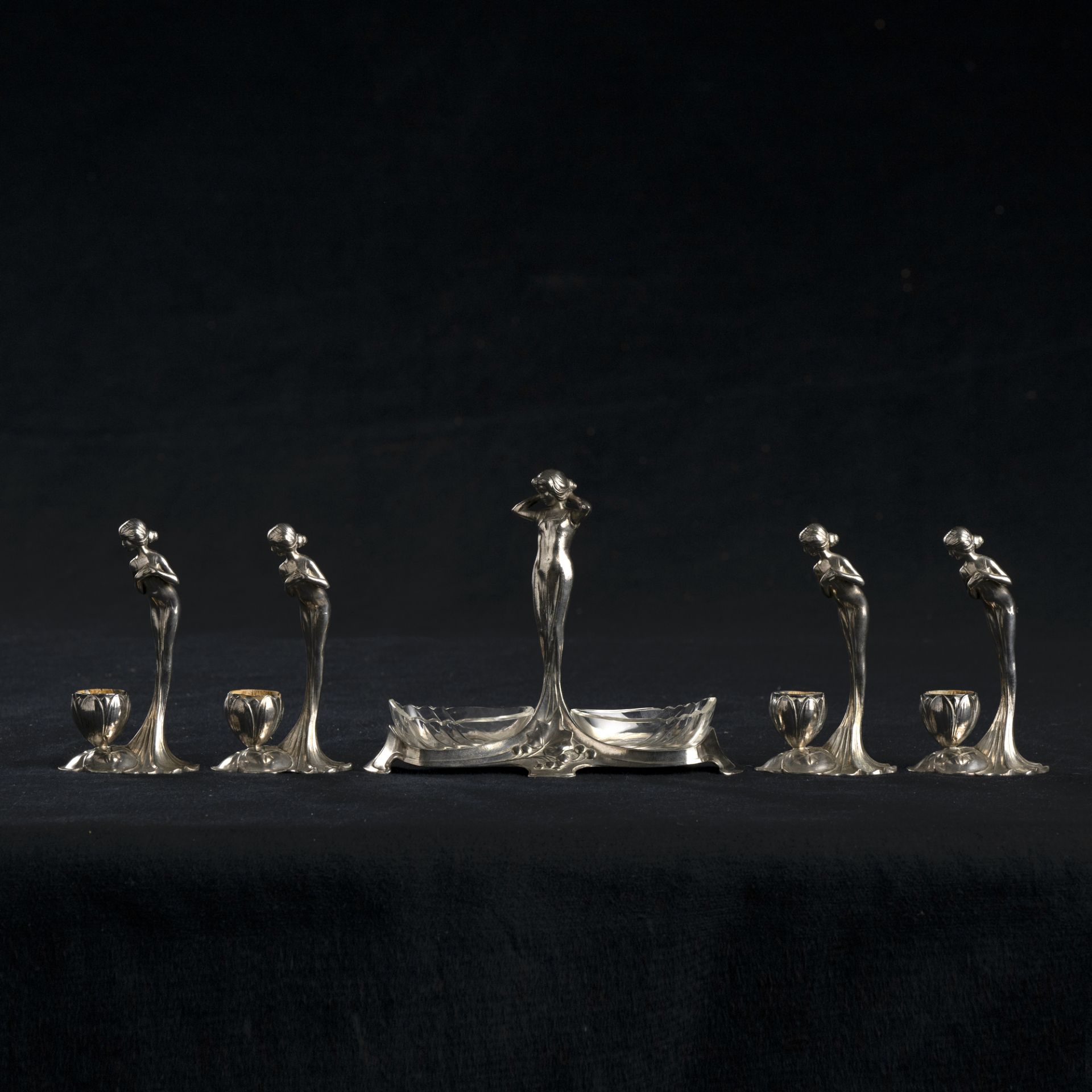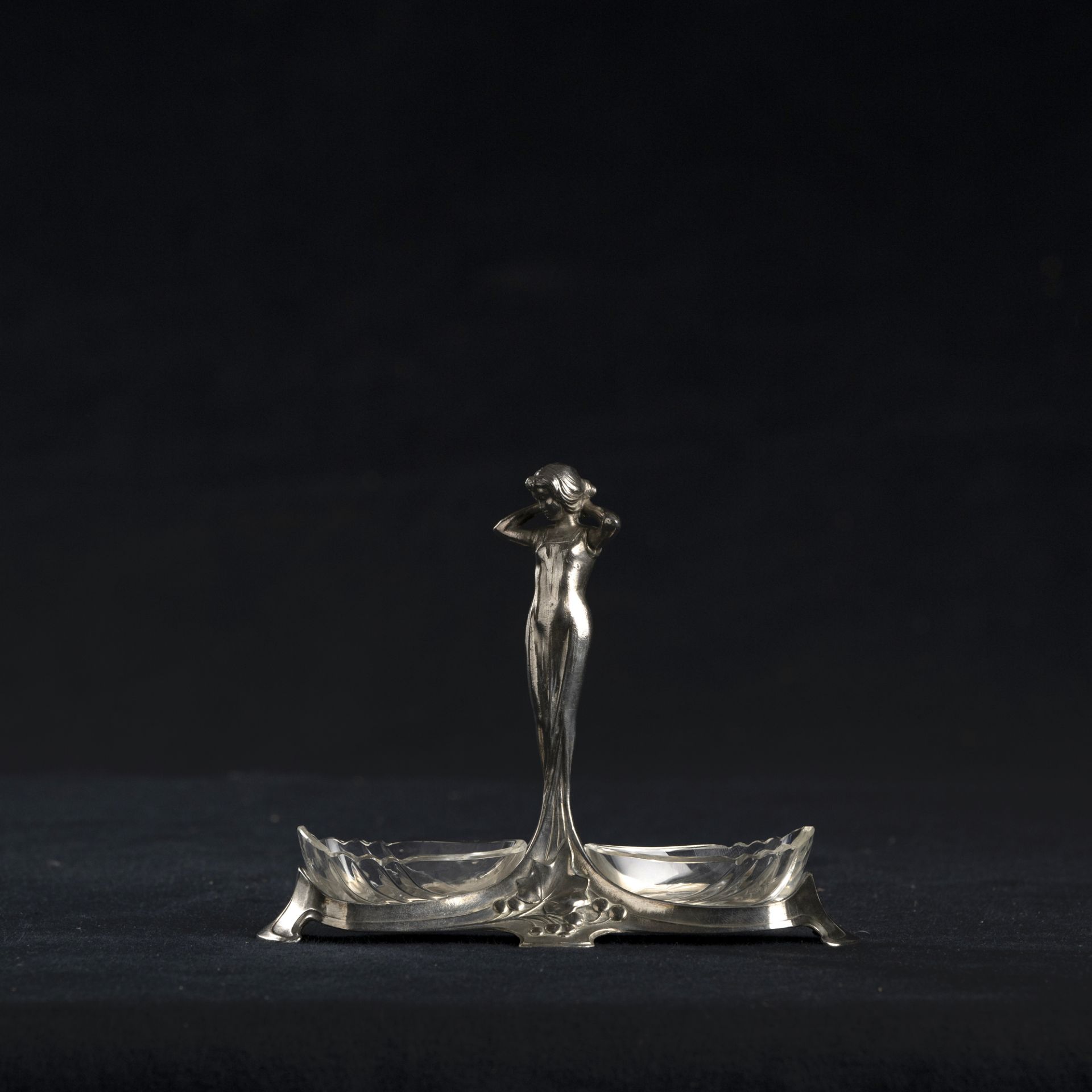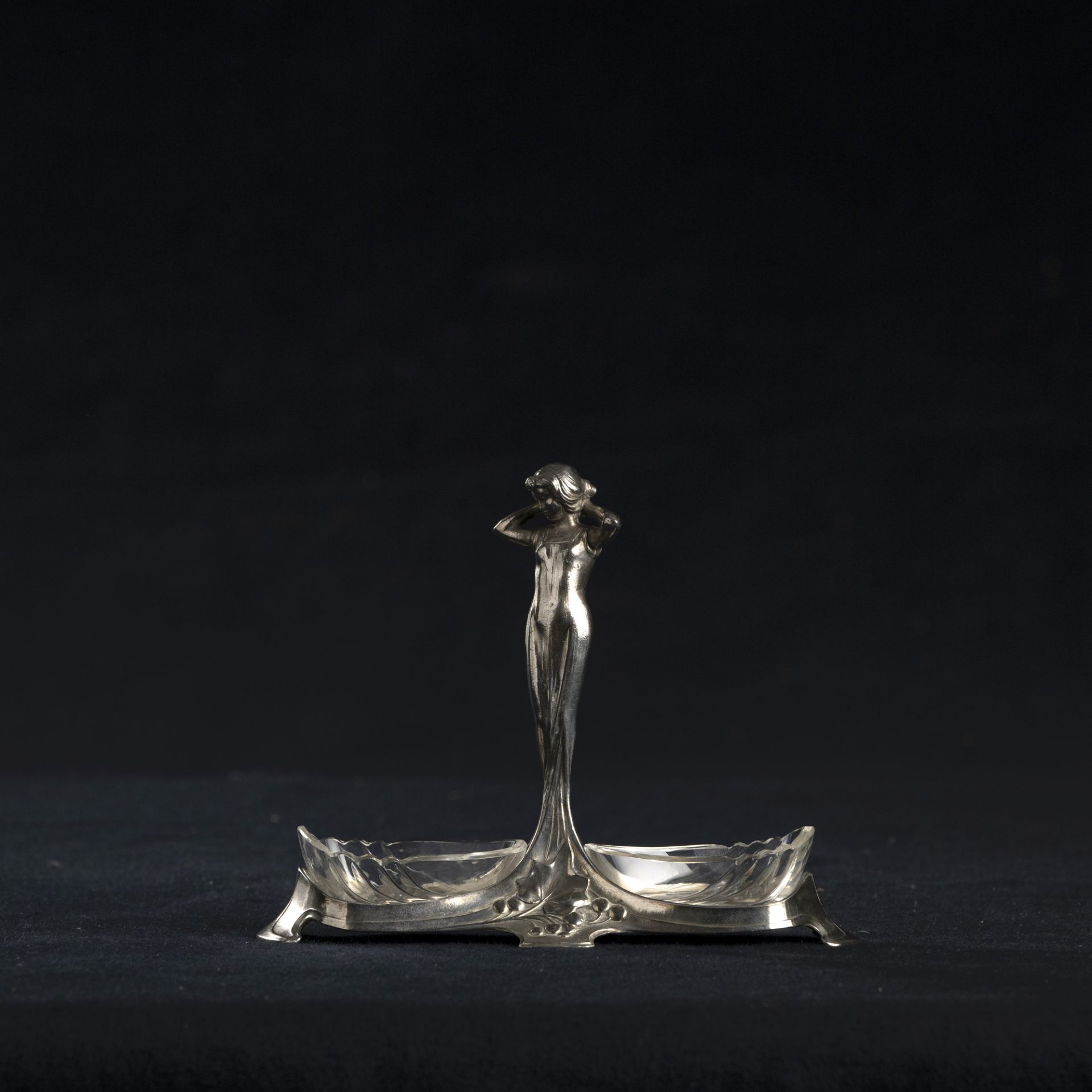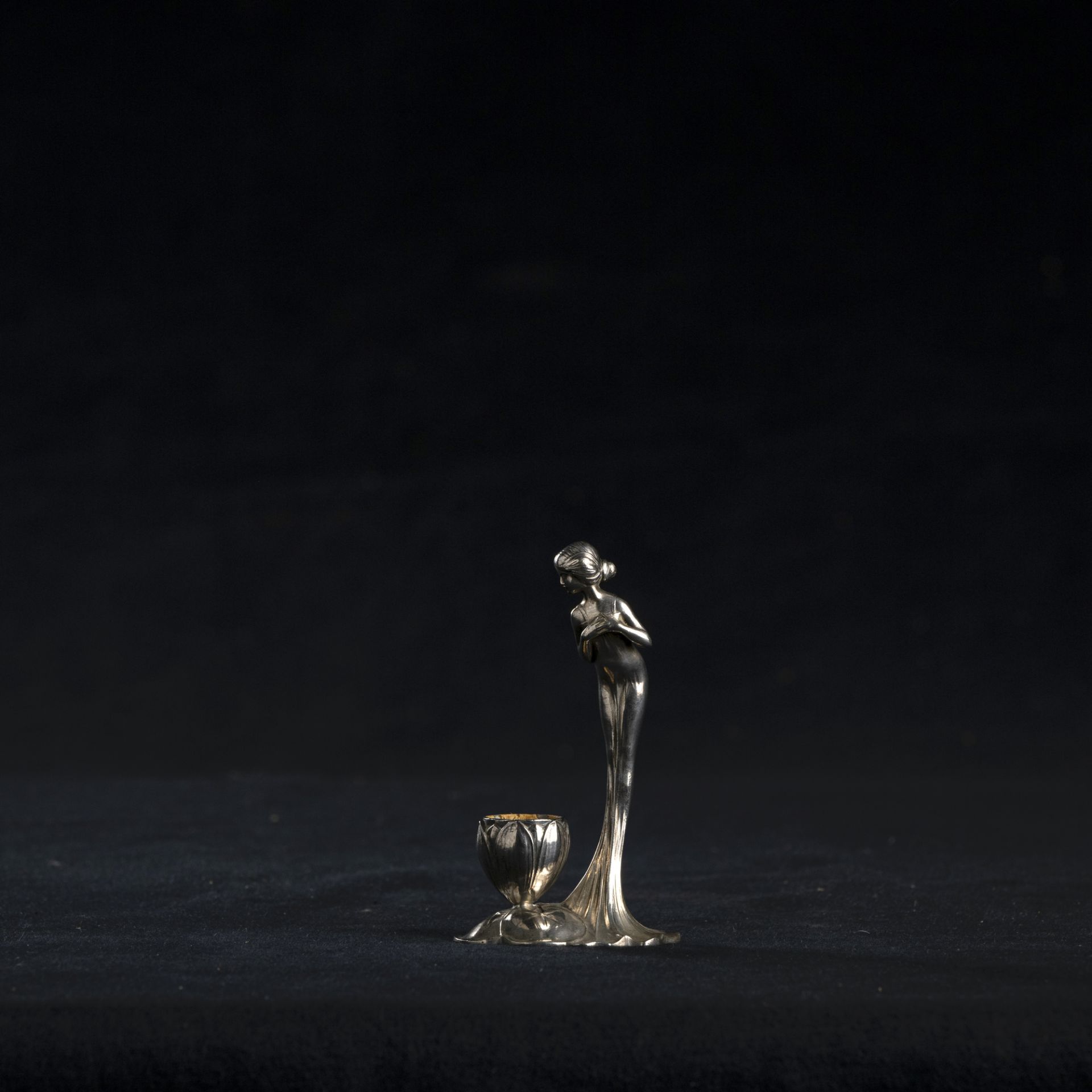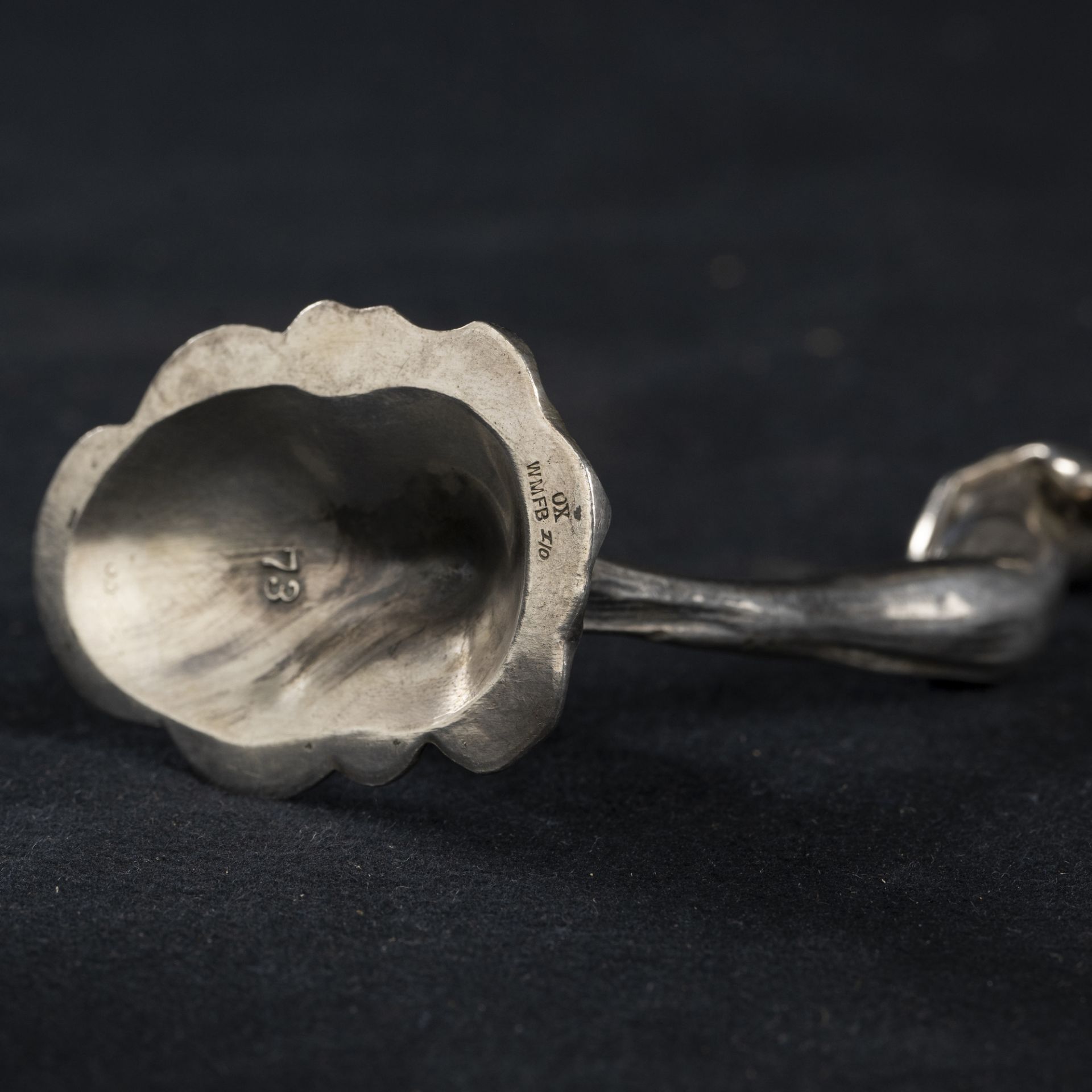342
Quattro portacandele e una saliera in metallo argentato
Quattro portacandele e una saliera in metallo argentato
Decorate con figure femminili
Marchiate WMFB (Württembergische Metallwarenfabrik)
Germania periodo ArtNouveau inizio XX secolo
h 11,5 cm (portacandele)
h 14,5 cm (saliera)
WMF è l'abbreviazione di Württembergische Metallwarenfabrik, in inglese Wurtemberg Metalware Factory, creata nel 1880 dopo la riuscita fusione di due fonderie del Wurtemberg, la fabbrica Geislingen di Daniel Straub (Straub & Sohn) e la fabbrica Esslingen di Alfred Ritter (A. Ritter & Co.)
La prima fonderia ebbe più successo commerciale, mentre la seconda utilizzava una tecnologia più avanzata di deposizione galvanica d'argento, che fu applicata per la prima volta a Esslingen dal chimico tedesco Carl Haegele nel 1871
Nel 1881, dopo il ritiro di Daniel Straub, Carl Haegele divenne amministratore delegato di WMF
Nello stesso anno lo stabilimento di Esslingen fu smantellato e le sue attrezzature furono incorporate nella fonderia di Geislingen
Nei successivi trent'anni il WMF conobbe un periodo di rapida espansione, che durò fino all'inizio della guerra mondiale nel 1914
Il marchio di quattro lettere è le combinazione della parola "WMF" con una delle seguenti lettere: "M" o "B", in modo da annotare il metallo di base utilizzato per l'argentatura, che significa ottone ("M" da Messing , il nome tedesco dell'ottone) o una lega contenente stagno, il cosiddetto Britannia metal ("B"), rispettivamente
Four candlesticks and a salt cellar in silver metal
Decorated with female figures
Marked WMFB (Württembergische Metallwarenfabrik)
Germany, early 20th century
h 11.5 cm (candlesticks)
h 14.5 cm (salt cellar)
WMF is the abbreviation of Württembergische Metallwarenfabrik, in English Wurtemberg Metalware Factory, created in 1880 after the successful merger of two foundries in Wurtemberg, Daniel Straub's Geislingen factory (Straub & Sohn) and Alfred Ritter's Esslingen factory (A. Ritter) & Co.)
The first foundry was more commercially successful, while the second used more advanced silver galvanic deposition technology, which was first applied in Esslingen by the German chemist Carl Haegele in 1871
In 1881, after Daniel Straub's retirement, Carl Haegele became CEO of WMF
In the same year, the Esslingen plant was dismantled and its equipment incorporated into the Geislingen foundry
Over the next thirty years the WMF experienced a period of rapid expansion, which lasted until the start of the World War in 1914
The four-letter mark is the combination of the word "WMF" with one of the following letters: "M" or "B", so as to note the base metal used for silvering, which means brass ("M" from Messing , the German name for brass) or a tin-containing alloy, so-called Britannia metal ("B"), respectively
Quattro portacandele e una saliera in metallo argentato
Decorate con figure femminili
Marchiate WMFB (Württembergische Metallwarenfabrik)
Germania periodo ArtNouveau inizio XX secolo
h 11,5 cm (portacandele)
h 14,5 cm (saliera)
WMF è l'abbreviazione di Württembergische Metallwarenfabrik, in inglese Wurtemberg Metalware Factory, creata nel 1880 dopo la riuscita fusione di due fonderie del Wurtemberg, la fabbrica Geislingen di Daniel Straub (Straub & Sohn) e la fabbrica Esslingen di Alfred Ritter (A. Ritter & Co.)
La prima fonderia ebbe più successo commerciale, mentre la seconda utilizzava una tecnologia più avanzata di deposizione galvanica d'argento, che fu applicata per la prima volta a Esslingen dal chimico tedesco Carl Haegele nel 1871
Nel 1881, dopo il ritiro di Daniel Straub, Carl Haegele divenne amministratore delegato di WMF
Nello stesso anno lo stabilimento di Esslingen fu smantellato e le sue attrezzature furono incorporate nella fonderia di Geislingen
Nei successivi trent'anni il WMF conobbe un periodo di rapida espansione, che durò fino all'inizio della guerra mondiale nel 1914
Il marchio di quattro lettere è le combinazione della parola "WMF" con una delle seguenti lettere: "M" o "B", in modo da annotare il metallo di base utilizzato per l'argentatura, che significa ottone ("M" da Messing , il nome tedesco dell'ottone) o una lega contenente stagno, il cosiddetto Britannia metal ("B"), rispettivamente
Four candlesticks and a salt cellar in silver metal
Decorated with female figures
Marked WMFB (Württembergische Metallwarenfabrik)
Germany, early 20th century
h 11.5 cm (candlesticks)
h 14.5 cm (salt cellar)
WMF is the abbreviation of Württembergische Metallwarenfabrik, in English Wurtemberg Metalware Factory, created in 1880 after the successful merger of two foundries in Wurtemberg, Daniel Straub's Geislingen factory (Straub & Sohn) and Alfred Ritter's Esslingen factory (A. Ritter) & Co.)
The first foundry was more commercially successful, while the second used more advanced silver galvanic deposition technology, which was first applied in Esslingen by the German chemist Carl Haegele in 1871
In 1881, after Daniel Straub's retirement, Carl Haegele became CEO of WMF
In the same year, the Esslingen plant was dismantled and its equipment incorporated into the Geislingen foundry
Over the next thirty years the WMF experienced a period of rapid expansion, which lasted until the start of the World War in 1914
The four-letter mark is the combination of the word "WMF" with one of the following letters: "M" or "B", so as to note the base metal used for silvering, which means brass ("M" from Messing , the German name for brass) or a tin-containing alloy, so-called Britannia metal ("B"), respectively
PAINTINGS, DRAWINGS, ICONS, SILVER, FINE ART AND ORIENTAL ART
Auktionsdatum
Ort der Versteigerung
Für Lucas Aste Versandinformtation bitte wählen Sie +39 286882236.











.png)
